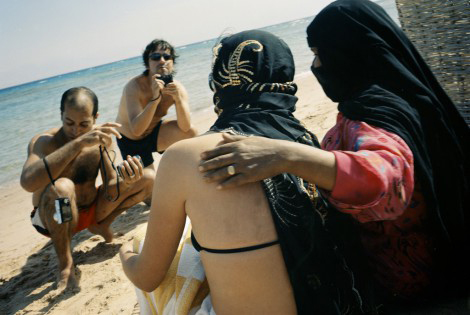Check out this new website, initiated by Ursula Biemann and Shuruq Harb, this month: “ArtTerritories is conceived as an independent platform for artists, thinkers, researchers and curators to reflect on their art practice and engage in critical exchange on matters of art and visual culture in the Middle East and the Arab World. Dedicated to the interview format, the initiative encourages discussion of artistic process with an emphasis on discursive art and media practices, collaborative initiatives, and cultural and institutional politics. ArtTerritories aims to define, connect and expand already existing art communities in the region as well as an ever-growing invested international arts community.”

Photograph by Ahmad Hosni, from his Go Down, Moses project
The following is a sample of an interview with photographer Ahmad Hosni.
Ursula: The book is the result of intense but somewhat undirected exposure to desert experience with its chance encounters, local stories and tourist ethnographies, tinted by a literary reading of an eclectic range of writers, some of whom are discussed in the book.
How did you go about synthesizing all this material?
Ahmad: I wouldn’t call it ‘desert’ experience… Maybe ‘[land]scape’ experience is a better way of putting it. But let me answer your question. As you might expect, the synthesizing was the most challenging part of the project. I had over 20 articles, journals of diaries and notes.
First, you need to absorb as much as you can. Then you try, heuristically, to see if anything makes sense at all. Sometime it doesn’t. Yet through this process of aggregation and accumulation of ideas, the body of work begins to develop its own selfhood and make demands. And you respond to that. Eventually, you get to the critical point where you are faced with a question that can’t readily be answered. It itches you. It has a grip on you. The desire to find an answer and the process of formulating it is where concepts and frameworks emerge.
I came face to face with this situation in the course of reading William Faulkner’s Go Down, Moses. I was bemused by the title – “What did this book have to do with the Biblical story of Moses for it to deserve that title?†I wondered. The book did not seem to have much to do with it: it is a novel about the American South, about race relations, disenfranchisement, the wilderness, the land, deliverance, many things. And it’s a difficult novel.
The next step was to investigate the semiotics in both narratives, Faulkner’s as well as the Biblical one. This is the beauty of mythology. It is not about authenticity, it’s not about verisimilitude, about being truth-like; it just makes more sense the more it is uttered…, the more it is appropriated, the more it is pirouetted, re-appropriated. Faulkner knew that long before Barthes. And I thought, “If Faulkner used it, then I probably can tooâ€. So I was thinking, “If only I can borrow the title – borrow Faulkner’s scheme of things – to make sense of my [land]scape experience and bring the story back to where it belongs, it would be my way to pay a tribute to Faulkner, to the spirit of his work.â€
For the full interview, click here.